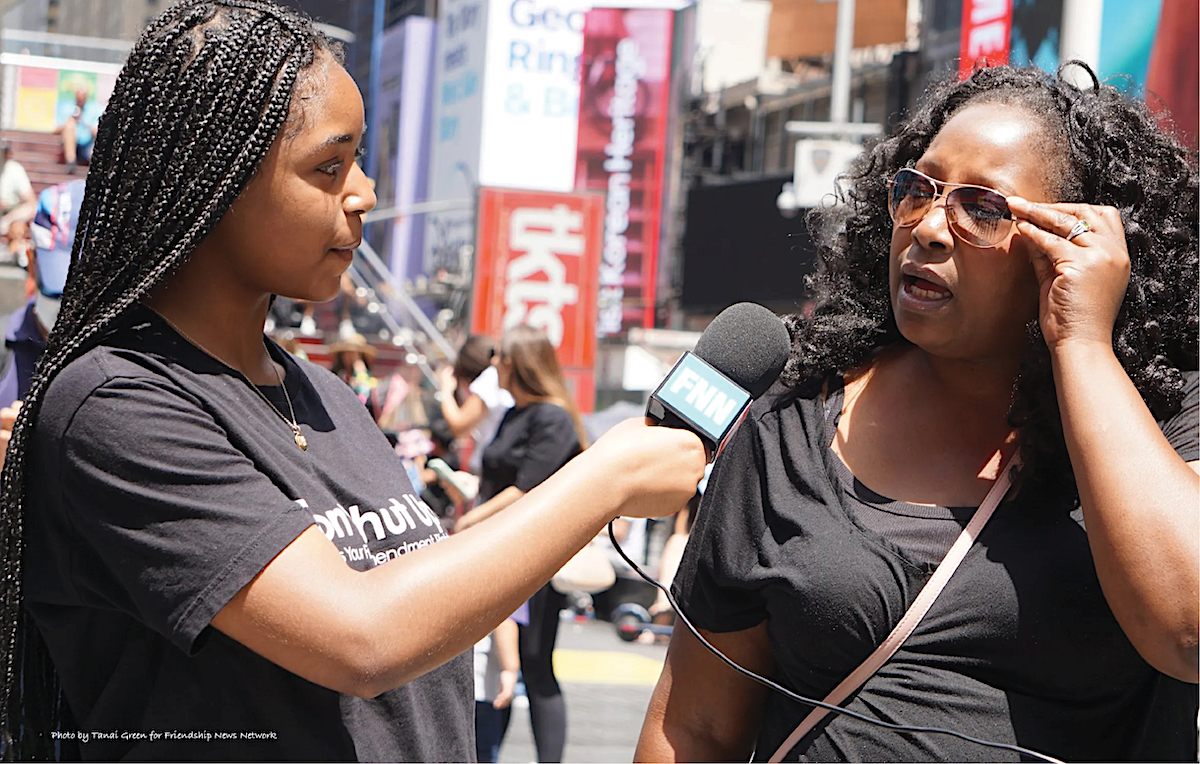
“I had saved up enough money and felt like I was secure enough to buy a home in my own backyard,” Merritt, an advisor at Friendship Collegiate Academy Early College (FCA), a 750-student charter high school in D.C., tells Word In Black. “I was humbled very quickly.”
“I don’t want our people to be erased, in a sense”
ANAERA BURNS, FORMER FRIENDSHIP COLLEGIATE ACADMEY STUDENT
A group of student journalists Merritt advised also noticed how their neighborhoods were changing. After all, in 2019, the movement #DontMuteDC was created during a public battle over the traditional go-go music being played on an iconic street corner in the District.
That same year, through the school’s journalism program — Friendship News Network — the teens decided to make a documentary exploring the impact of gentrification on D.C.’s Black population. The result is the recently released Fading Color: How Gentrification Changed Chocolate City.
The nearly 22-minute-long film took the students three years to complete due to the COVID-19 pandemic. It features interviews with community members, folks who were forced out of their homes, as well as politicians, developers, and activists.
A Student Perspective
“I don’t want our people to be erased, in a sense,” says former FCA student Anaera Burns, now a communications major at SUNY Oswego. Burns was one of three students remaining on the FNN team after production was disrupted by the pandemic.
“When we go Downtown, we’ll see these new buildings like Whole Foods and Starbucks,” Burns says. “But when we go back to our own neighborhoods, it’d be run down. We’d see liquor stores, stuff like that.”
Even after graduating from FCA, Burns stuck with the documentary project because she felt the need to tell the stories of people and communities being directly impacted by policymakers and investors.
“This goes beyond D.C. — D.C is a major city, but there are other cities where gentrification has completely ruined and pushed out Black and brown people,” Burns says. “This is a national problem.”
The District was 71% Black in 1970, but between the 2000 and 2020 U.S. Census, the Black population decreased from 59 to 41%.
NATIONAL COMMUNITY INVESTMENT COALITION STUDY
Gentrification and displacement of residents were most intense in the nation’s biggest cities between 2000 and 2013, a National Community Investment Coalition study shows, and D.C. was hardest hit. The District was 71% Black in 1970, but between the 2000 and 2020 U.S. Census, the Black population decreased from 59 to 41%.
Maniya Porter, 20, a former Friendship Collegiate Academy student and FNN journalist, was knee-deep into the project when gentrification came knocking on her doorstep and forced her to leave the neighborhood she’d lived in for five years.
“I had to move [from] the home I was at because of gentrification. The rent at the place I was at with my mother just kept going up, so we had to leave,” Porter says.
The Challenge of Gentrification
“Gentrification basically is refurbishing a low-income community or neighborhood,” Anika Baker, a D.C resident, said in the documentary. “Basically pushing them out to reconstruct it to become more likable, or ‘safe,’ but in terms of safety — it’s mostly to make white people feel comfortable.”
The student documentary explores how redlining, eminent domain, and disinvestment were some of the direct causes of Black people being pushed out of the nation’s capital — and the racial wealth gap plays a role, too.
Income disparity data included in the documentary shows in 2007, the white median income in the District was $116,000, and the Black median income was $43,000 – a $73,000 difference. By 2021, however, the racial wealth gap had widened even more. The white median income had grown to $134,000, with the Black median income only being $49,000 – a difference of $85,000.
Although U.S homeownership rates climbed to 65.5% in 2020, Black people continue to face obstacles toward homeownership — like being 7% more likely to be rejected for mortgage loans.
“This is our understanding of how the game is played. Now, this is a way we can start moving pieces on the board,” Merritt says.
Exploring Solutions
Some community members featured in the documentary talked about community investment and ways in which Black people can band together to return some color back to their own neighborhoods.
Gentrification basically is refurbishing a low-income community or neighborhood. Basically pushing them out to reconstruct it to become more likable, or ‘safe,’ but in terms of safety — it’s mostly to make white people feel comfortable.
ANIKA BAKER, D.C RESIDENT
“We have to start to invest our money back into our own properties,” Randall White, the football coach at FCA, said in the documentary. “Let’s really come together and put our resources together to buy a block of real estate.”
Buying joint homes, implementing financial literacy problems in Black spaces, and creating programs for youth to learn about the housing market are some potential long-term solutions to combatting the gentrification that’s already here, Merritt tells Word in Black.
“When you examine the causation, you also have the opportunity to look at how we can reverse it,” Merritt says. “If we understand the majority of the African Americans have low income, then what can we do to make sure they’re financially stable?”
She says it’s understandable for students to want to “leave home and explore other places, but there’s a certain charm to D.C — the music, the culture, the arts” — and so we owe it to them to solve the way gentrification forces Black people out of communities.
“It’s just so many great things in this area, and I would hate to just up and leave solely because I couldn’t afford to live here.”










